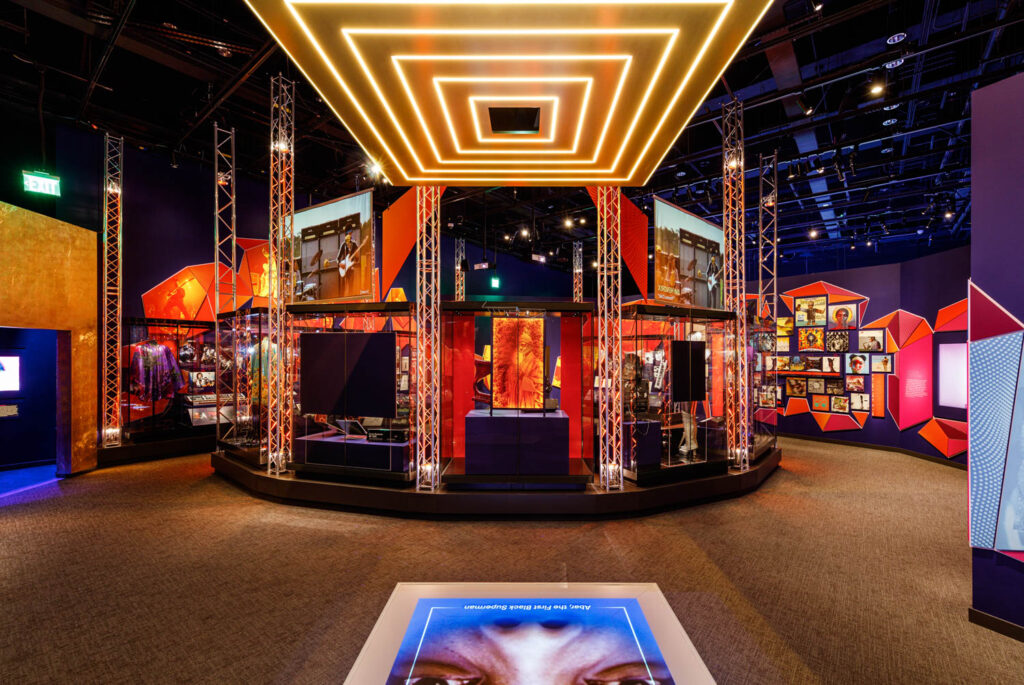
This Must-See Exhibit Explores Narratives Around Black Liberation
Design in all its forms, from furnishings to fashion, offers a rich narrative of people and place, as evident in “Afrofuturism: A History of Black Futures,” on view through August 18, 2024 at The Smithsonian’s National Museum of African American History and Culture in Washington, D.C. The exhibition, which opened last spring, offers an immersive exploration of Afrofuturist expression over the last century, displaying more than 100 objects across mediums, including music, film, comic books, and more, that reflect pressing ideas around Black liberation, identity, and agency.
“Afrofuturism continues to evolve as a concept, an aesthetic, and as a cultural platform with a deep intellectual tradition and history,” Kevin M. Strait, curator of the exhibition, tells Interior Design. “The term was originally coined in scholarly circles to explore how Black writers and artists have utilized themes of technology, science fiction, fantasy, and heroism to envision stories and futures of Black liberation and convey a more genuine and empowered image of the Black experience.” Afrofuturism offers what Strait calls “a powerful lens to view and interpret the Black experience in an increasingly technological world, and an identity for the multitude of activists, intellectuals, and creatives who envision new futures through their cultural output.”
Exploring Afrofuturism Through Design


In the realm of design, the term takes on many forms. “Design is one of the places in which Afrofuturism has its fullest visual expression,” shares Michelle Joan Wilkinson, the museum’s curator of architecture and design. “As we saw with the elaborate production design, set design, and costume design for the 2018 Black Panther film, opportunities to represent Black futures benefit from expertise across design fields. Even furniture design can be employed to convey Afrofuturist aesthetics.” The set for the film’s sequel, Black Panther: Wakanda Forever, includes a stool and chair by designer Jomo Tariku, she adds.
As for a unifying thread among Afrofuturist aesthetics, Wilkinson says expression is often individualized, noting that it’s difficult to to define characteristics or palettes across fashion, graphic design, and interiors. “I’m usually interested in what the creator identifies as Afrofuturist elements in their work—and often this has to do with their own research into African diaspora cultures, into Afrofuturist literature, and the knowledge of predecessors in the genre across creative disciplines,” she continues. “That said, references to space or the cosmos are often part of Afrofuturist imaginings.”
The cosmos play a prominent role throughout the 4,300-square-foot exhibition at the National Museum of African American History and Culture, which is designed to take attendees on a journey through time and beyond guided by Afrofuturism pioneers. Glimpse Octavia Butler’s typewriter, Nichelle Nichols’ Star Trek uniform, and Nona Hendryx’s spacesuit-inspired costume worn while performing with LaBelle. And take a peek at Chadwick Boseman’s Black Panther costume. “I’m certain that as new audiences encounter and learn from the history of Black futures, the scope of what Afrofuturism is will continue to evolve,” says Wilkinson, noting that such imaginative world-building will likely encourage generations to come to discover new frontiers of architecture and design.
Walk Through ‘Afrofuturism: A History of Black Futures’ Ongoing in Washington, D.C.









read more
DesignWire
10 Questions With… Football Star Turned Designer Michael Bennett
From a Super Bowl win to recent design exhibitions, Michael Bennett continues to reinvent his career—and the nature of design—with an eye toward Black culture.
DesignWire
10 Questions With… Jomo Tariku
Forms related to African heritage, everyday life, and rituals find their ways into designer Jomo Tariku’s furniture. Go behind his process.
DesignWire
10 Questions With… Artist and Poet, Avery R. Young
Artist and poet Avery R. Young shares a behind the scenes look at his contributions to the latest edition of the Chicago Architecture Biennial (CAB 5).
recent stories
DesignWire
10 Questions With… Painter Daniel Rich
North Carolina and Berlin-based painter Daniel Rich shares the details behind his geometric interiors and what he sees inside architectural forms.
DesignWire
Behind the Mic: Get to Know Jeremiah Brent
What does Jeremiah Brent, interior designer and host of the Ideas of Order podcast, have to say about home? It turns out, quite a lot.
DesignWire
Design Icon and Hall of Famer Gaetano Pesce Dies at 84
Gaetano Pesce, a visionary designer, artist and sculptor who enchanted the world with his unique sense of materiality, has passed at 84.





